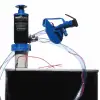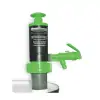GoatThroat Pumps for Furniture Manufacturing
GoatThroat® Pumps provide countless enterprises with a safer, easier method for transferring chemicals. That includes small, medium-sized, and large businesses in the furniture industry. Why should you consider GoatThroat when sourcing a furniture industry chemical pump? While there’s no substitute for planned maintenance programs that seek out, identify, and mitigate causes of spills and contamination, one thing is for sure: manual drum-emptying practices frequently generate spills that present management with OSHA-related work safety issues or problems with EPA regulations. Plant management is never happy with the loss of costly, usable chemicals, particularly when a low-cost, preventive approach exists. GoatThroat designs a chemical transfer pump that not only meets the requirements set by OSHA and the EPA, but also integrates into your annual budget by cutting short-term costs associated with a reduction in wasted product and long-term costs, associated with lawsuits, claims, and citations by regulating agencies.
Why should you consider GoatThroat when sourcing a furniture industry chemical pump?
Producing high-quality furniture means working with timber, fabric, cushion, metals, and other sturdy materials that require processing treatments. The machines used to shape and process the materials into a final product also need chemical maintenance. Frequently, the handling of these chemicals takes caution and must follow OSHA and EPA requirements. GoatThroat provides quality products for use as furniture industry chemical pumps. With one of our formaldehyde pumps, your factory can handle chemicals more efficiently and safer from improper chemical exposure and harmful emissions.
Wood stains, varnishes, spray treatments, and other finishing products aren’t as harmful as the more corrosive chemicals used to keep heavy machinery in working order, but are still flammable and emit toxic fumes. Utilizing personal protection equipment, unwanted exposure to these chemicals can be limited. With GoatThroat quality pumps, potential accidents, spills, and leaks are greatly reduced. The added chemical safety provided by our closed system pumps makes workplace safety even easier. The manual design of the pumps even removes the concern of sparks igniting stored chemicals.
The improved ability to fully drain chemical containers over gravity-powered pump solutions will reduce chemical waste and increase your chemical reserves’ effective output. With the extra savings in chemical cost, reduced cost of chemical-related workplace accidents, and by cutting chemical waste disposal, your manufacturing facility will benefit in both the short term and long term.
Our pumps are designed with safety and efficiency at the forefront. Our experience working with over 2000 chemicals recorded in our chemical compatibility guide allows GoatThroat to craft durable, reliable chemical pumps for industry-grade needs. Search through the guide to find the right solution for your chemical needs or get into contact with a professional from GoatThroat for assistance in acquiring a chemical transfer pump system for your furniture manufacturing business. We want to make choosing GoatThroat pumps the best and the easiest choice for industrial chemical handling solutions.
Furniture Industry Pump Applications
- Eliminate spills and leaks when transferring chemicals from storage drums to portable containers
- Seal away exposure to toxic chemicals from the handler
- Reduce the need to reposition or move large and heavy storage drums
- Dispense chemicals with great control over the rate of flow
- Handle portable chemical applications with less risk of leaks and spills
- Apply a chemical solvent cleaning solution to tools
GoatThroat’s chemical-resistant pumps are perfect to use for furniture manufacturers’ industry-grade chemical applications. Handling large amounts of concentrated hazardous materials like acetone, formaldehyde, or chemical solvents becomes a simple and safe process with our reliable pump designs. Our pumps can make handling every chemical in use in your facility a safer and more efficient process.
Using our products takes minimal training to master. This allows every factory worker who needs access to chemical use the ability to use reserves more efficiently. In return, chemical reserves will last longer as every drop is utilized. Product finishing solvent used to remove leftover processing chemical residue, flashing, and foreign debris will last longer as well.
Chemical Drum Transfer
You may be dealing with the constant threat of dangerous, costly, and time-consuming spills if you currently rely on the tip-and-pour method to manually extract liquids from containers at your facility. The reality is that human error and gravity both conspire to make this a very risky and inefficient method for handling liquids. There is a better way to complete a barrel pump transfer from a larger drum to a smaller drum. GoatThroat pumps create a consistent, controlled pour that is activated with a single motion. These pumps do not rely on gravity to dispense liquids. What’s more, they are designed to eliminate contamination, leakage, and spills.
The easy-to-use nature of our pumps allows everyone to easily perform best practices following OSHA and EPA compliance requirements. Easier working methods allow your workforce to reduce unnecessary energy expenditure which translates to a greater focus on the quality of production. It also helps to contribute to a happier and healthier workplace environment. The higher the morale of your team, the more productive they will be.
It’s an easy choice to allow GoatThroat pumps to provide your furniture manufacturing facility with the hand drum chemical transfer pumps and other pump solutions. Use our existing catalog of products to find the right pump fit for your needs or get into contact with a professional at GoatThroat to start developing a unique solution for your company’s needs.
Read our case studies to learn more about how the furniture industry utilizes our safety chemical pumps and how they make a difference in meeting EHS goals.
Download Library.
Click on a title to download.
- Case History - Furniture Manufacturer
- Tech Article - Plant Services
- Tech Article - Prevention Beats Cleanup
Recommended Products
GoatThroat Groundable Santoprene Pump and TapShop Now
GoatThroat Viton PumpShop Now
Pneumatic Adapter with RegulatorShop Now
Case Studies.
Chemical Dispensing Woes Cured at North Carolina Furniture Plant
New pumps allow resin casting company to substantially reduce acetone spills and avoid EPA fines. Companies that use aggressive chemicals often purchase those chemicals in 55-gallon drums, and the majority of spills happen when getting the chemicals out of the drums. Workers often manually lift and tip the drum or use a fork truck to pour the contents into another container, a cleaning tank, or a process vessel. At Carolina Casting Inc., High Point, N.C., drums of acetone were stored upright to avoid leakage. To dispense the solvent, the 350-lb. drums were moved to another location, placed on a cradle, attached to bonding and grounding wires, and tilted to permit dispensing through hand control of a faucet. After dispensing, they were returned to the storage area. The process was slow, labor-intensive and subject to spills, according to Dan Stiles, a plant engineer. The company tried using rotary hand-crank pumps with …
Furniture Industry Chemical Pumps
GoatThroat Pumps for Furniture Manufacturing GoatThroat® Pumps provide countless enterprises with a safer, easier method for transferring chemicals. That includes small, medium-sized, and large businesses in the furniture industry. Why should you consider GoatThroat when sourcing a furniture industry chemical pump? While there’s no substitute for planned maintenance programs that seek out, identify, and mitigate causes of spills and contamination, one thing is for sure: manual drum-emptying practices frequently generate spills that present management with OSHA-related work safety issues or problems with EPA regulations. Plant management is never happy with the loss of costly, usable chemicals, particularly when a low-cost, preventive approach exists. GoatThroat designs a chemical transfer pump that not only meets the requirements set by OSHA and the EPA, but also integrates into your annual budget by cutting short-term costs associated with a reduction in wasted product and long-term costs, associated with lawsuits, claims, and citations by regulating …
Chemical Dispensing Woes Cured at North Carolina Furniture Plant
New pumps allow resin casting company to substantially reduce acetone spills and avoid EPA fines.
Companies that use aggressive chemicals often purchase those chemicals in 55-gallon drums, and the majority of spills happen when getting the chemicals out of the drums. Workers often manually lift and tip the drum or use a fork truck to pour the contents into another container, a cleaning tank, or a process vessel.
At Carolina Casting Inc., High Point, N.C., drums of acetone were stored upright to avoid leakage. To dispense the solvent, the 350-lb. drums were moved to another location, placed on a cradle, attached to bonding and grounding wires, and tilted to permit dispensing through hand control of a faucet. After dispensing, they were returned to the storage area. The process was slow, labor-intensive and subject to spills, according to Dan Stiles, a plant engineer.
The company tried using rotary hand-crank pumps with the drums in a vertical position, but pump pulsing led to splashing and the pumps were unreliable and costly to repair. Air-driven pumps were turned down because of high initial costs, expensive parts and high maintenance.
“We decided to try pressure-action pumps,” says Stiles. Sourced from GoatThroat, “The polypropylene pumps proved reliable and permits us to keep our drums in an upright position.” The pumps are held in place with an airtight rubber compression fitting. Pressure is added by pumping a piston several times, and flow is controlled with a spring-loaded tap. An internal safety design limits pressure to 7 psi, which meets UN safety standards.
At Carolina Casting, fixed grounding and bonding wires are hooked directly to an adapter that delivers compressed air at 2ps. “This has proved ideal for dispensing into small containers,” says Stiles, and also is available in larger, mobile units for filling 20-gal. to 40-gal. containers at 3.3 gpm. “No more bucket-carrying of acetone,” he says. “The new procedure is faster and safer, and has helped us exceed our environmental compliance requirements.”
Dispensing Chemicals Safely Saves You Money
The majority of chemical spill problems occur while getting the chemicals out of the drums. Many small- to moderate-sized companies rely on workers to manually lift and tip the containers and pour the chemical into a smaller drum, so spills are inevitable, and spill kits and related equipment are necessary. While there’s no substitute for planned maintenance programs that seek out, identify, and mitigate causes of spills and contamination, one thing is for sure: manual drum-emptying practices frequently generate spills that present management with OSHA-related work safety issues or problems with EPA regulations.
Plant management is never happy with the loss of costly, usable chemicals, particularly when a low-cost, preventive approach exists. Handling Drums of Acetone at Carolina Castings. Located in High Point, NC, Carolina Casting, Inc. is a leader in polyester resin-based products for the furniture industry. For its customers, Carolina Castings creates bun feet, finials, moldings and roto-casted table bases to include items such as chair backs, ornate fixtures, tabletops, mirror frames, highly complex assembled table bases and pedestals, and more. The process Carolina Castings employs can supply texture and color for the striking results their customers require.
Prevention Beats Cleanup
A large volume of acetone has to be dispensed daily. Large faucet-equipped drums of the chemical were stored upright in the chemical storage room. But for use, the 350 lb drums had to be moved to another location, placed on a cradle in a prone position, have bonding and grounding wires attached, and be tilted to permit dispensing through hand control of the faucet. After dispensing, the bonding and grounding wires were disconnected and the container returned to the storage area and again placed in an upright position. According to plant engineer Dan Stiles, the process was slow, labor intensive, and subject to potential spills when transferring the flammable solvent. “We use acetone as a solvent to clean hand tools, small containers, and machine flushing operations,” noted Stiles. “However, our primary use is to clean our finished product so that it is free of chemical component, flashing, and foreign debris. The finished product is then ready for painting or staining with a similar texture and acceptance of the final finish just as if it were its wood counterpart.”
The Search
Dissatisfied, Stiles tried using a rotary hand-crank pump on the container, but found this unsatisfactory because the liquid would pulse at the spout and splash on the employees during dispensing. Additionally, these pumps were unreliable after a few months, requiring costly repairs. Stiles then investigated air-driven pumps, but this was unsuitable because of high initial costs, expensive replacement parts, and high maintenance costs.
The Solution
“We decided to try a pressure action pump sourced from GoatThroat Pumps,” said Stiles. “These polypropylene pumps proved reliable, and permitted us to keep our drums safely in an upright position. We now have 2 rigs. At the fixed location, we utilize fixed grounding and bonding wires that are hooked directly to the drum. We have added the air compressor adapter which, with only 2 psi, delivers the acetone to small containers for our labor force to use at their benches for ‘small work’. The solution has proved ideal for dispensing on demand (shown above, right), and the same setup can also be used for larger mobile units (shown left), which fill 20-40 gal day tanks. “At a rate of 4 gallons a minute, it takes one man about 12 minutes to fill the 40 gal tank,” said Stiles. “No more carrying buckets of acetone across the factory, which consumed the better part of 30 minutes and could hurt the employee’s back. We have replaced o-rings a couple of times, but the original pumps are still in use after 4 years. The new procedure is faster and safer, and has helped us exceed our environmental compliance requirements.”




